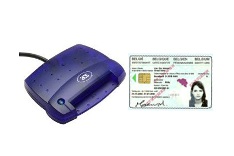Friday, July 8, 2011

The electronic identity card or
eID is the statutory or legal identity card in Belgium. Every Belgian citizen in Belgium above 12 years of age has an eID. In addition, foreigners, both within the EU and non-EU citizens residing in Belgium, having fulfilled the necessary residing requirements of the country, are also given an eID.
With this eID, you are able to prove your identity and travel within the EU countries.
And it does not stop there. The eID, with a pincode, has a microchip which contains information not visible on the card itself such as one's address and electronic data (known as digital certificates). These certificates confirm your identity when you use the eID card reader. Through the eID, you can:
- prove your identity on the Internet
- place an electronic signature
- apply for official documents and fill in official forms
- and more...
Whilst anyone with an e-card reader
can read the details on an eID by inserting the eID into the card reader and using the publicly available software, not everyone
may - without a legitimate purpose and with the consent of the data subject.
The presentation or submission of the eID card is not governed by the Data Protection Law. However, once the information on the identity card is read, copied or manually recorded, processing of personal data has taken place and is subject to the application of the Data Protection Law.
As such, it is of primary importance to establish that there is a legitimate purpose for the reading of the eID. Where the information is visible on the eID card to the naked eye, and sufficient to achieve the relevant purpose, the data controller should only copy/process that information and
should not proceed with an electronic reading of the chip. This is because, as earlier stated, the microchip contains both information already visible on the card as well as hidden information which may not be necessary for the relevant purpose. If the data controller reads the information contained in the chip anyway, he is then processing irrelevant and excessive information unnecessary for his purpose(s) and is in breach of the Data Protection Law.
Hence, if you happen to be asked for your eID to be read by the card reader, which seems to be quite common in registering for mobile phone subscriptions and tenancy agreements, do exercise your right to know the specific purpose for reading your eID, and if the information required is visible on the card without having to read the chip, then do know that the data controller has no ground for making this request.
Category: